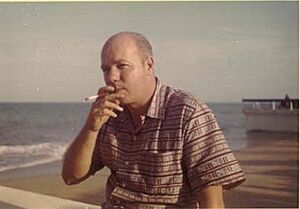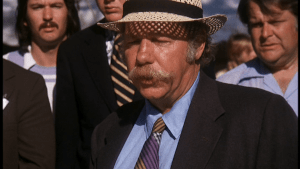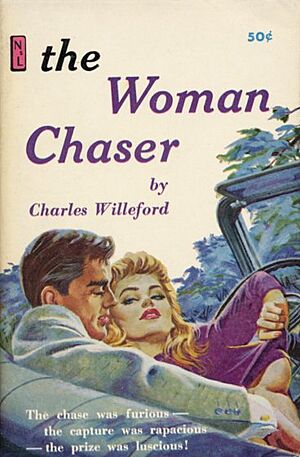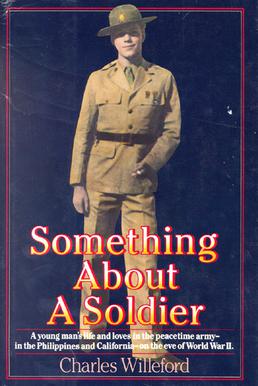Charles Willeford facts for kids
Quick facts for kids
Charles Willeford
|
|
|---|---|

Willeford in the 1980s
|
|
| Born | January 2, 1919 |
| Died | March 27, 1988 (aged 69) |
| Resting place | Arlington National Cemetery, Arlington, Virginia, US |
| Occupation |
|
Charles Ray Willeford III (born January 2, 1919 – died March 27, 1988) was a talented American writer. He wrote many different kinds of books, including novels, poems, and stories about his own life. Charles Willeford became very well known for his exciting detective stories about a character named Hoke Moseley. His book Miami Blues (1984) was especially popular and is still seen as a very important crime novel from that time. Several of his books have even been made into movies, like Cockfighter and Miami Blues.
Contents
Charles Willeford's Early Life
Charles Ray Willeford III was born in Little Rock, Arkansas, on January 2, 1919. When he was young, he faced some tough times. His father passed away in 1922, and his mother also died in 1927. After that, he lived with his grandmother in Los Angeles.
During the Great Depression, a time when many people had little money, Charles made a big decision. At just thirteen years old, he hopped on a freight train in Los Angeles. He pretended to be seventeen and traveled by train along the Mexican border for a whole year.
Charles Willeford's Career Journey
Charles Willeford had a very interesting career path, starting with military service. In 1935, he joined the California National Guard. Soon after, he joined the regular United States Army. He spent two years in the Air Corps in the Philippines, driving fire trucks and gas trucks.
He left the Army in 1938 but rejoined in 1939. This time, he joined the Air Corps again, then transferred to the 11th Cavalry. Here, he learned to ride and care for horses. He even learned how to shoe horses!
In 1942, Charles went to infantry school in Georgia. He became a tank commander in the 10th Armored Division and fought in Europe during World War II. He was part of the famous Battle of the Bulge. For his bravery, he received several awards, including the Silver Star and the Bronze Star. He also earned the Purple Heart for being wounded in battle.
After the war, he continued his military service. From 1947 to 1949, he was stationed in Japan with the 24th Infantry Division. He ran an army radio station and was promoted to master sergeant.
Becoming a Writer
Charles Willeford's first book of poems, Proletarian Laughter, was published in 1948. In 1949, he left the army and went to Peru to study art. However, he was asked to leave because he didn't have a college or high school diploma.
He then rejoined the Air Force in 1949. While serving, his first novel, High Priest of California, was published in 1953. It was printed with another writer's novel and sold many copies. He continued to write, and two more of his novels were published before he finally left active military duty in 1956.
Charles Willeford's Later Life
After leaving the Air Force in 1956, Charles Willeford tried many different jobs. He worked as a professional boxer, an actor, a horse trainer, and a radio announcer. He even studied painting in France for a while.
He decided to go back to school, earning a degree from Palm Beach Junior College in 1960. Then, he studied English literature at the University of Miami, getting his bachelor's degree in 1962 and his master's in 1964. During this time, he also worked as an editor for a mystery magazine and reviewed books for the Miami Herald.
From 1964 to 1985, Charles taught English and philosophy at Miami-Dade Community College. In 1971, his novel The Burnt Orange Heresy was published. This book is often considered one of his best crime novels.
He also wrote the screenplay for the 1974 movie Cockfighter, which was based on his own novel. He even had a small acting role in the film!
The Hoke Moseley Series
In 1984, Charles Willeford published Miami Blues. This was the first book in his popular Hoke Moseley detective series. These books became very famous for their unique and sometimes funny take on detective stories.
The success of Miami Blues and its sequels brought him a lot of attention and financial success. He received a large payment for his fourth Hoke Moseley book, The Way We Die Now. This book was released in early 1988 and was his last novel.
Charles Willeford's Death
Charles Willeford passed away from a heart attack on March 27, 1988, in Miami, Florida. He was 69 years old. He was buried at Arlington National Cemetery in Arlington, Virginia.
Charles Willeford's Writing Style
Charles Willeford's crime novels were quite special. Many people say they don't quite fit into the usual crime genre. One key feature of his writing, especially his early books, was his humor. It was often a bit grumpy, sometimes a little rude, and often made fun of typical crime stories.
Crime novelist Lawrence Block described Willeford's books as "quirky." He wrote about unusual characters and seemed to ignore what others thought. His stories focused more on the characters themselves rather than just the plot or fancy language.
Critics also noted that Willeford's writing lacked strong emotions or over-the-top drama. His writing style was calm and steady, almost neutral. This made his stories about strange characters feel very real.
Willeford's wide interests showed up in his books. For example, High Priest of California mentions famous writers like T. S. Eliot and James Joyce. The Burnt Orange Heresy even jokes about modern art movements like Dada and Surrealism.
His books sometimes touched on serious topics. The Black Mass of Brother Springer (1958) was one of the first novels to show the civil rights movement. Even without being so direct, his work often had a deeper message. He showed a world where competition was everywhere, and people struggled to find their own way.
Charles Willeford's Impact
Many famous writers admired Charles Willeford. Elmore Leonard once said, "Nobody writes a better crime novel." He is seen as one of the writers who helped develop the "hard-boiled" crime story in the 1950s. These stories often focused on criminals instead of just detectives and explored the darker, more unusual parts of human nature.
Mitch Kaplan, an expert on South Florida books, believes that Miami Blues started the modern era of Miami crime fiction. Many crime writers in Miami today have been influenced by Willeford. Fellow writer James Lee Burke said he owed a "great debt" to Willeford for advice on writing.
Even director Quentin Tarantino was inspired by Willeford's unique mix of humor and violence. Tarantino said his movie Pulp Fiction was closer to modern crime fiction like Charles Willeford's work. In 2004, Jonathan Yardley of The Washington Post called him "one of our most skilled, interesting, accomplished and productive writers."
Four of Willeford's books have been made into movies:
- Cockfighter (1974), starring Warren Oates. Willeford wrote the screenplay himself.
- Miami Blues (1990), starring Alec Baldwin and Fred Ward as Hoke Moseley.
- The Woman Chaser (1999), starring Patrick Warburton.
- The Burnt Orange Heresy (2019), starring Claes Bang.
Willeford also turned his first novel, High Priest of California, into a play. It was first performed in New York City in 1988.
Charles Willeford's Works
Here are some of the books Charles Willeford wrote:
Hoke Moseley Series
There were four published books in this popular detective series:
- Miami Blues (1984)
- New Hope for the Dead (1985)
- Sideswipe (1987)
- The Way We Die Now (1988)
He also wrote an unpublished story for the series called Grimhaven.
Other Novels
- High Priest of California (1953)
- Pick-Up (1955)
- Wild Wives (1956)
- Honey Gal (1958) (also known as The Black Mass of Brother Springer)
- The Woman Chaser (1960)
- The Whip Hand (1961) (also known as Deliver Me from Dallas!)
- Understudy for Love (1961)
- No Experience Necessary (1962)
- Cockfighter (1962)
- The Burnt Orange Heresy (1971)
- The Hombre from Sonora (1971) (also known as The Difference)
- The Shark-Infested Custard (1993)
Poetry
- The Outcast Poets (1947)
- Proletarian Laughter (1948)
- Poontang and Other Poems (1967)
Short Stories and Nonfiction
- The Machine in Ward Eleven (1963) (short stories)
- A Guide for the Undehemorrhoided (1977) (nonfiction)
- Off the Wall (1980) (nonfiction)
- Something About a Soldier (1986) (autobiography about his early military life)
- New Forms of Ugly: The Immobilized Hero in Modern Fiction (1987) (literary criticism)
- Everybody's Metamorphosis (1988) (short stories and essays)
- I Was Looking for a Street (1988) (autobiography about his childhood and teenage years)
- Cockfighter Journal: The Story of a Shooting (1989) (autobiography about the filming of Cockfighter)
- Writing and Other Blood Sports (2000) (essays on writing)
- The Second Half of the Double Feature (2003) (short stories and autobiographical sketches)
See also
- List of people from Little Rock, Arkansas






